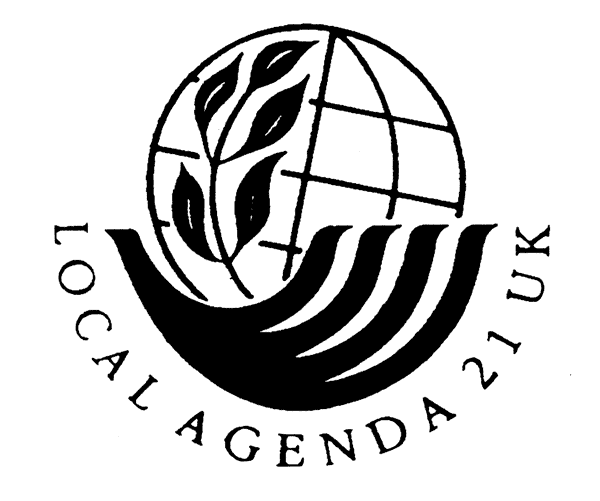
What is Agenda 21?
Local Agenda 21 - part 2.
Three years ago, Britain signed a new international agreement pledging a commitment towards community empowerment. Since then ‘Agenda 21’ has become the new buzz word sweeping through grass roots organisations, whether working to clean up local rivers, setting up community centres or providing local housing schemes. But what is it and does it mean anything? Andy Johnson looks into potentials of a new flag.
Squall 9, Jan/Feb 1995, pg. 15.
Agenda 21 is a document signed by 70 countries, including Britain, at the Earth Summit in Rio (The United Nations Conference on Environment and Development - UNCED) in 1992.
It is a long, rambling, vague tome, outlining certain policies that countries should adopt in order to achieve “sustainable development”.
At its heart is the principle that all sections of a community, including businesses, trade unions and grass roots organisations should join together to provide basic shelter, food and warmth (development) to the poor and vulnerable, in ways that do not harm the environment (sustainable).
What has caught the imagination of grass roots organisations is that this partnership includes local authorities; and that by 1996 every local authority in the country is directed by the agreement to be undergoing its implementation.
Agenda 21 contains much that was specifically designed for developing countries. As such, its brief covers an enormous range of topics, from the role of farmers and indigenous peoples, to “combating deforestation. Some of its terms of reference, specifically those applying to the poor, apply equally to so called ‘wealthy’ countries such as Britain. Especially now that the levels of poverty in Britain are on the increase.
It is important to remember that Agenda 21 is not a binding agreement. There is absolutely nothing under international law to compel governments to act on their promises. In diplomatic parlance, it is know as ‘soft law’.
The effectiveness of Agenda 21 will therefore come from people being familiar with what it says and applying pressure on the authorities to keep to their internationally agreed directives.
T ake the words of Michael Heseltine at a pre-conference meeting in March 1992:
“In our view, Agenda 21 should represent a high level political commitment. The key to Agenda 21 is that this is a document for everyone with a part to play in delivering sustainable development, not just governments.”
Reading between the lines, Michael Heseltine seems to be handing the Agenda over to local resources and Human skills, directing them to provide the basic necessities for their own communities.
The chapters that affect the poor in this country are all in Section 1 of the Agenda. They are Chapter 3 - Combating Poverty, Chapter 4 – Changing Consumption Patterns and Chapter 6 - Protecting and Promoting Human Health.
Each chapter is further divided into 3 sections. If we take Chapter 3 - Combating poverty as an example, the sections are The Problem (Basis for Action), The Solution (Objectives); Achievement (activities).
Under ‘Basis for Action’ in Chapter 3, are such pearls of wisdom as: “The eradication of poverty and hunger (and) greater equity in income distribution remain major changes everywhere.… A specific anti-poverty strategy is therefore one of the basic conditions for ensuring sustainable development.”
Under ‘Objectives’ we have: “To provide all persons urgently with the opportunity to earn a sustainable livelihood,” and “To develop strategies and programmes of poverty eradication and alleviation, employment and income generation.”
Under ‘Activities’: “Focus on the empowerment of local and community groups,” and “Contain immediate measures to enable these groups to alleviate poverty.”
They are all very fine words, even if they don’t say anything specific. But that emptiness leaves the field wide open for groups to come up with their own initiatives and at least be in with half a chance of getting the local authority. In a sense it is a flag with which groups can walk into their local authority and claim the ground.
Already such projects include cultivating local land (allotments, permaculture projects etc.), LETS Schemes, local produce and co-ops coming under the heading of developing the local economy and tree planting, wildlife sanctuaries and meadows.
It shows what just may be possible, but Roae Bridger, the Agenda 21 Officer at The Ecology Centre, advises that ideas are going to have to be original and serious. It’s no good just tacking Agenda 21 onto the back of any old half baked scheme.
She is also optimistic about local authority action, on the grounds that they have some environmental awareness and are always competing with each other for one up(wo)manship.
“Broaden the idea,” she says. “Make it a community project and try and involve as many people as possible. Look at what other groups are doing and look at it from a different angle.”
“Agenda 21: A Plain Language Guide” published by the Centre for our Common Future
“Rescue Mission Planet Earth" - A children’s version of Agenda 21 published by Peace Child International is association with the United Nations,
“A step by step Guide to Local Agenda 21” published by the Local government Management board, and other books on the subject, are all available from the London Ecology Centre, Shelton Street, Covent Garden, London, WC2 9HJ. Send an SAE for a list.
Related Articles
Local Agendas - how protesters, squatters and travellers can work with it - by Anna Makismow - Squall 9, Jan/Feb 1995
The Roots Of Sustainable Development - Local Agenda 21: doing it anyway. Andy Johnson investigates. Squall 10, Summer 1995.
Populating The International Promise - Will the Government act on its Agenda 21 commitments? By Jim Carey, Squall 10, Summer 1995.
